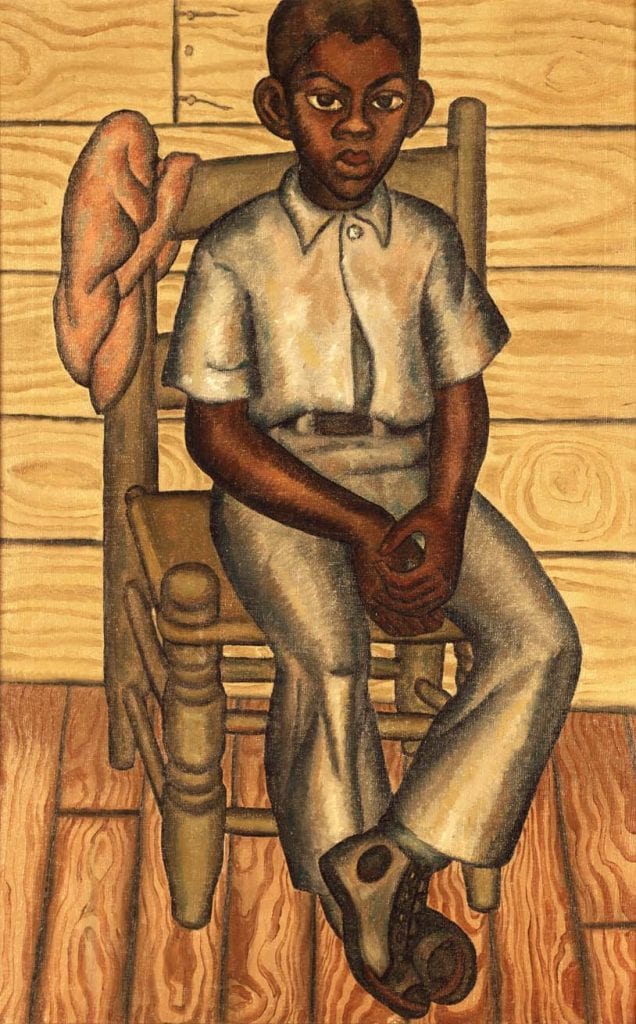Español abajo
Express your emotions through portraiture.
Download Activity
Kathleen Blackshear, Portrait of Robert Gould, 1932, Oil on canvas, 39” x 24”, Gift of the Roger H. Ogden Collection, 2003.1
Kathleen Blackshear is known for her American Scene and Depression Era regionalist style portraits of African Americans. She became a unique teacher of the arts by encouraging her students not only to visit art galleries, but to also spend time in museums of natural history, zoos and cultural institutions for inspiration.
Instructions
Step 1: Look at the artwork, Portrait of Robert Gould. How do you think the boy in the painting is feeling? How can you tell he is feeling this way? What do you notice about his body language?
Step 2: Think about an emotion that you want to express. Maybe you can smile to express happiness or frown to express sadness.
Step 3: Once you have decided on an emotion to express, ask a friend, parent or guardian to guess what emotion you expressing.
Step 4: Ask the same person to use a camera or camera phone to take your portrait. If a camera or a camera phone isn’t available, the person can use their hands and imagination. Ask them to make a frame by extending their thumbs and index fingers. Touch the tips of the index fingers to the thumbs to make a box. Close one eye to focus. Say cheese!
Step 5 (Optional): Repeat the activity. This time express a different emotion. Look in books or on the Internet to find other examples of portraits. What emotions are these people expressing?
Vocabulary
Portrait – an image of a person; genre of art
Expression — the process of making known one’s thoughts or feelings
SEE MORE FUN AT-HOME ACTIVITIES FOR KIDS ON THE O BLOG!
QUESTIONS? EMAIL EDUCATION@OGDENMUSEUM.ORG
____________________________________________________________________
Lunes de movimiento: Expresar emociones a través del retrato
Expresa tus emociones a través del retrato.

Kathleen Blackshear, Portrait of Robert Gould, 1932, Oil on canvas, 39” x 24”, Gift of the Roger H. Ogden Collection, 2003.1 | Kathleen Blackshear, Retrato de Robert Gould, 1932, óleo sobre lienzo, 39” x 24”, Obsequio la Colección de Roger H. Ogden, 2003.1
Kathleen Blackshear es conocida por sus retratos de afroamericanos, de estilo regionalista correspondiente al movimiento de la American Scene y la era de la Gran Depresión. Se convirtió en una maestra de artes única al alentar a sus estudiantes no sólo a visitar galerías de arte, sino también a pasar tiempo en museos de historia natural, zoológicos e instituciones culturales en busca de inspiración.
Instrucciones
Paso 1: Observa la obra de arte Retrato de Robert Gould , de Kathleen Blackshear. ¿Cómo crees que se siente el niño del cuadro? ¿Cómo puedes saber que se siente así? ¿Qué notas sobre su lenguaje corporal?
Paso 2: Piensa en una emoción que quieras expresar . Tal vez puedas sonreír para expresar felicidad o fruncir el ceño para expresar tristeza.
Paso 3: Una vez que hayas decidido qué emoción expresar, pídele a un amigo, padre o tutor que adivine qué emoción estás expresando.
Paso 4: Pídele a la misma persona que use una cámara o un teléfono con cámara para tomar tu retrato . Si no hay una cámara o un teléfono con cámara disponible, la persona puede usar sus manos y su imaginación. Pídeles que hagan un marco extendiendo sus dedos pulgar e índice. Junta las puntas de los dedos índices con los pulgares para hacer una caja. Cierra un ojo para enfocar. ¡Sonríe!
Paso 5 (Opcional): Repite la actividad. Esta vez expresa una emoción diferente. Busca en libros o en Internet para encontrar otros ejemplos de retratos. ¿Qué emociones están expresando estas personas?
Vocabulario
Retrato: una imagen de una persona, género artístico.
Expresión: el proceso de dar a conocer nuestros pensamientos o emociones
¡VE MÁS ACTIVIDADES DIVERTIDAS PARA NIÑOS PARA HACER EN CASA EN EL O BLOG!
¿PREGUNTAS? ENVÍA UN EMAIL A EDUCATION@OGDENMUSEUM.ORG.
Translation by Agostina Coll
